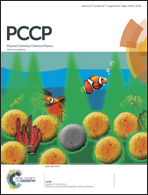Theoretical study on molecular design and optical properties of organic sensitizers†
Abstract
A series of organic sensitizers based on different configurations such as D–π–A, D–[π]n–A, D–π–[A]n, [D]n–π–A, D–π–A–π–D, D–π–[A]n–π–D and D–[π–A]n–π–D (where n = 1–4) are designed using theoretical methods. The effects of repeating π-linker, donor–acceptor moieties and the substitution of additional donor–acceptor moieties on the optoelectronic properties have been addressed. Our results show that the strength of the acceptor units changes the mono band absorption into dual band absorption in all the considered strategies. We found that repeating π-linker/donor moieties in the D–π–A series enhances the intensity of the absorption and can tune their absorption spectra from UV-to-visible and visible to near IR regions by repeating acceptor units. Also, the present results indicate that the D–π–A–π–D configuration shows improved optical properties than the conventional D–π–A structure. This theoretical study explores the new configurations and design strategies of organic dyes for developing efficient light harvesting devices working in the whole visible and near IR regions.


 Please wait while we load your content...
Please wait while we load your content...